The premise is simple: read one comic every day for the entire year. It seems like a simple task but there is no way that I read 365 comics last year, even if you count the individual issues in collections. So, this year, I am committing myself to this reading challenge, in the hope that I can broaden my reading habits and fully engage with my favourite hobby again.
Another double header. Partly to help me catch up on the writing side, but mostly because I’ve had a laid back couple of weeks, mainly reading Paul Cornell’s run on Demon Knights. I’m not a big follower of DC Comics, but when The New 52 kicked off in 2011, I picked up a bunch of titles. And, for the most part, I enjoyed them to start with. I followed Supergirl until the end (40 odd issues); I got to Scott Snyder and Jeff Lemire’s crossover with Swamp Thing and Animal Man; I enjoyed Snyder’s Batman for the first couple of arcs; and, of course, I have all 16 issues of Cornell’s Demon Knights.
When it comes to DC heroes, I tend to dip in and out of the characters, caring little for the continuity. Demon Knights is a great series that feels self-contained, although it does contain hints of links to the greater DC universe and previous incarnations of the characters, but it deals with continuity in a matter-of-fact way. Part of the story addresses contradictions in continuity head on but never makes it a major part of this series. For this reason, it was a perfect jumping on point and allowed the creators to tell their own story featuring the characters without worrying about stepping on the toes of history. The Big Two should do this more often. I’m aware that The New 52 is seen as something of a disaster, but there are a number of titles under that banner that I still re-read today, more so than other DC comics.
But before Demon Knights..
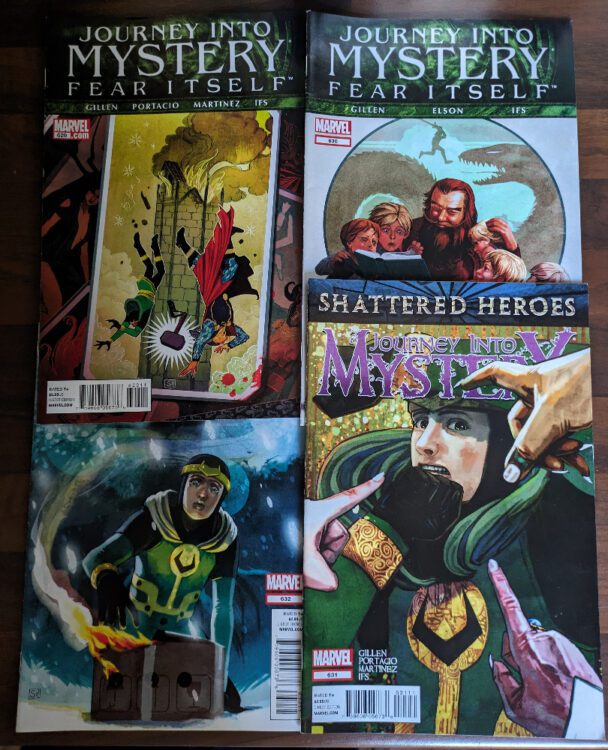
Credit: Marvel Comics
Comic numbers 314 – 317: Journey Into Mystery #629 – 632
I stand by everything I have said previously about the Fear Itself event, however, after reading the last two Journey Into Mystery tie-in issues, I realize that I might have misunderstood which title was the “main” one. Issue #629 explains everything that Loki has been up to, how it fits with the Fear Itself storyline, and what actually happened at the end of the event. It all makes sense and is beautifully told by Kieron Gillen, Whilce Portacio, Doug Braithwaite, and a host of inkers, colorists and letterers.
“I’m winning the war against Fear Itself, and no one appreciates it,” says Loki in the opening page of this issue. And he isn’t wrong.
Issue #630 is even better. Volstagg is rescued from the roots of the World Tree, where his body has been in hiding while his essence has been controlling the Destroyer Armor (you need to read the story to understand). The voluminous Asgardian then returns home to tell his brood how he defeated the Serpent — twice. In this single issue, Volstagg’s story tells you everything you need to know about Fear Itself in an easy to follow and entertaining way. Volstagg’s version is better than Matt Fraction’s. It also creates a wonderful talking point for how comics have historically dealt with complex and long narratives: reducing the core elements to a few simple sound bites. This was the essence of Classic Comics Illustrated.
Volstagg’s story is simplified and, in some places, straight up lies but then again, aren’t all stories?
The following two issues deal with the aftermath of the big event story and sit under a new banner, Shattered Heroes. Issue #631 deals with the serious fallout from the battle with the Serpent: Thor’s death, Odin’s estrangement, the new ruling council of All-Mothers. But #632 has much more fun dealing with one particular consequence. This issue actually touches base with all of the main players in the comic but does it in such a way that it doesn’t feel like Gillen is just reminding readers who is where. Which is actually the mission statement for this issue.
Journey Into Mystery was the reason I managed to read all of Fear Itself, and I think I might continue reading until the end of Gillen’s run.
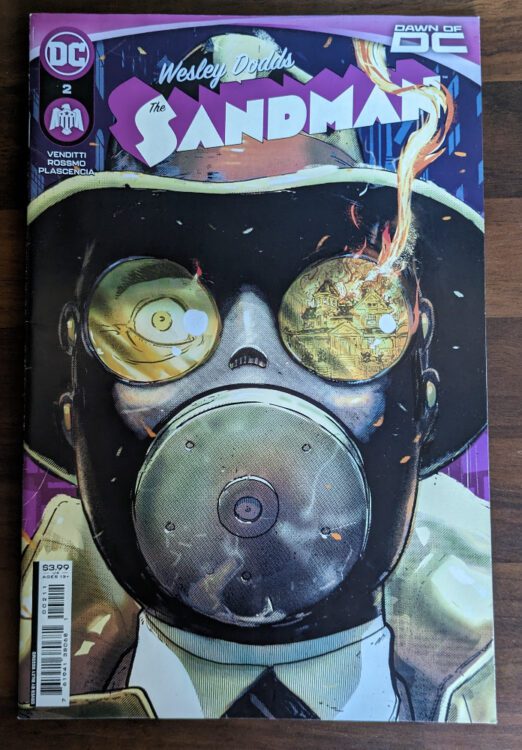
Credit: DC Comics
Comic Number 318: Wesley Dodds The Sandman #2
I picked this comic up randomly from the shop while browsing. I used to read the Vertigo Sandman Mystery Theatre title in the 1990s and enjoyed the pulp storylines and the noir aesthetic. It’s pleasing to see that this updated version still has the same sensibilities.
Robert Venditti and Riley Rossmo tell a wonderfully engaging story about a man obsessed and haunted by his inventions and actions. Rossmo’s artwork flips the action between comedy and thriller expertly, not allowing one tone to dominate. Ivan Plascencia’s color work assists in this by creating the atmosphere for each scene, allowing Rossmo’s exaggerated style to express urgency, horror, or farce as the script dictates.
This issue was thoroughly enjoyable, and at no point did I feel left out for not reading the first issue. The story drew you in, dropping any required backstory seamlessly into the narrative at the relevant points, and advanced at a comfortable pace. It left you feeling like you’d read a full story when, in fact, you’d only read part of one.
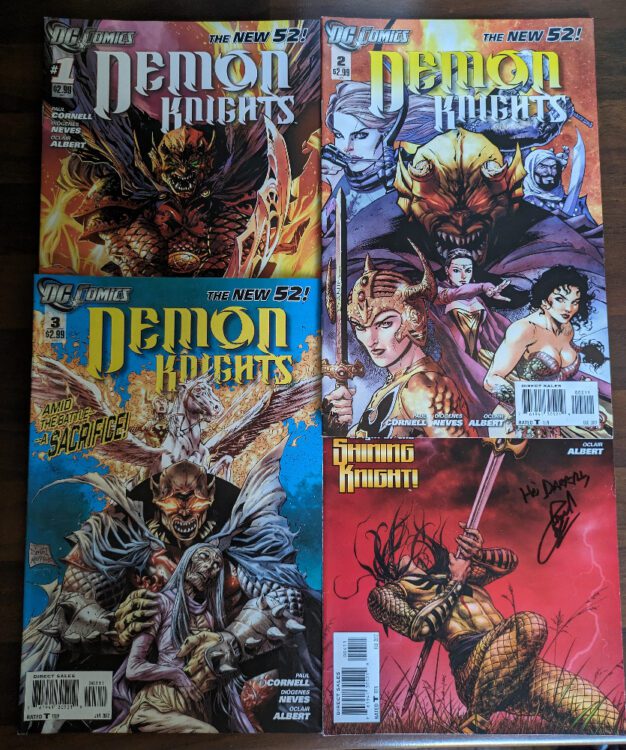
Credit: DC Comics
Comic Number 319 and 320 ( the end of this week): Demon Knights (New 52) #1-7
The first seven issues form the first of Cornell’s arcs. It is an origin story, of sorts, that introduces each of the ‘knights’ and brings them together for the first time to do battle against the Questing Queen and her unstoppable horde.
The central characters here are cover star Etrigan, part-time rhyming demon and occasional human host Jason Blood, and Madame Xanadu, an immortal witch. The complex relationship between these two forms the backbone of the story throughout the series and their importance is cemented by several flashback stories acting as their backstory. In fact, the opening issue starts with the fall of Avalon and the merging of Etrigan with Jason.
Demon Knights is a sword-and-sorcery story in the vein of modern superhero comics. Paul Cornell draws on his previous writing, which includes superhero, high fantasy, and urban supernatural stories. At the heart is a very British sense of humor which most readers will find endearing, although it may be a turn off for some.
Throughout the first seven issues, the heroes bicker their way through a siege on a small town. Each of the characters has a depth that makes their interactions exciting and even without the murderous horde knocking at the gates, there is enough conflict in the story to keep most comics going for years.
I’m a fan of Etrigan and often pick up comics with him in. I’m also a fan of Paul Cornell — he did write one of the best Nu Who episodes after all. So, it’s not surprising that I picked this comic up in 2011. What is surprising is how much I enjoy this comic. It’s big, and bold, and often quite daft, but the tight script and excellent artwork by Diogenes Neves and Oclair Albert, make it a worthwhile read.

Credit: DC Comics
On to Week 47
Most of this week has been taken up reading the final nine issues of Demon Knights. The story moves on from the siege, which turned out to be a triumph for the heroes (sort of), and a new mission is undertaken: to find the soul of Merlin.
The nine issues are packed with twisting narratives, seeing the heroes fight sea monsters, pirates, demonic hordes, and even themselves, again. At one point they become cursed by a light from the ruins of Camelot and have to face their true, evil, potential. Then they are forced into hell by the treacherous Etrigan before finding themselves in the middle of three armies, set for war. So, a lot happens.
The sword-and-sorcery excitement continues at breakneck speed as each of the knight’s characters are explored through the traumas they encounter. Despite the fact that a lot happens in a handful of issues, Cornell gives each of the characters time to breath and grow. By issue 15, these characters have come so far from where they started which is a great testament to the writers skills.
A selection of artist work on the title over these 15 issues, and each brings their own little twists to the pages while maintaining a general aesthetic so that the story reads as one, continuous adventure.
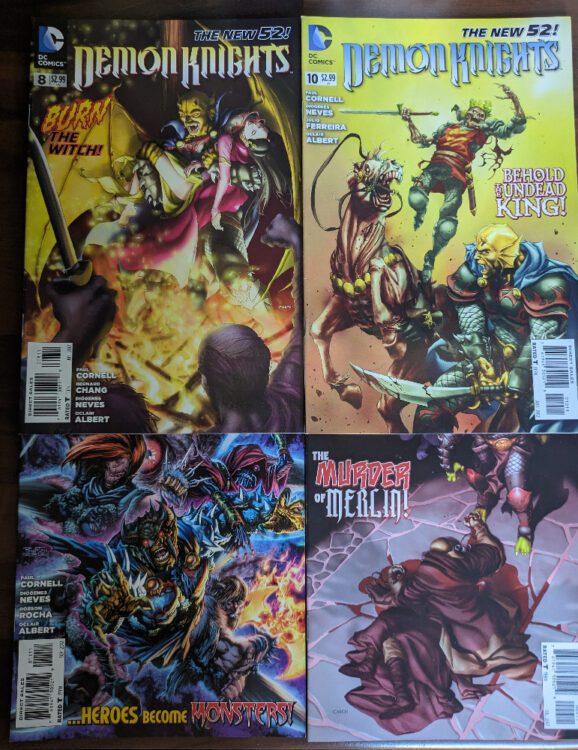
Credit: DC Comics
Demon Knights was a bold move by DC when they relaunched their entire line in 2011. It would have been easy to focus on the superhero stories and rebuild those brands. However, they released a number of different comics focusing on genres that were not very prevalent at the time, especially for the big publishers. The New 52 contained westerns, war comics, horror, and supernatural. At the center of it all was Paul Cornell’s take on mythological characters and stories. It was a pleasure to read then and still remains a worthwhile read today.
I can’t let this week pass, however, without mentioning Canary #1 from Dark Horse Comics. Written by Scott Snyder and drawn by Dan Panosion, this western is a superb piece of genre work. The story is gripping and the visuals are outstanding. Panosian uses the page layouts to their advantage when creating tension and employs the use of color like an expressionist painter drawing out emotions from a canvas. Issue 1 of Canary sat on my bedside table for a while before I got around to reading it and the wait was worth it. One of my favorite new comics that I’ve read this year.
Comics 321 to 327 ticked off (with plenty in hand).
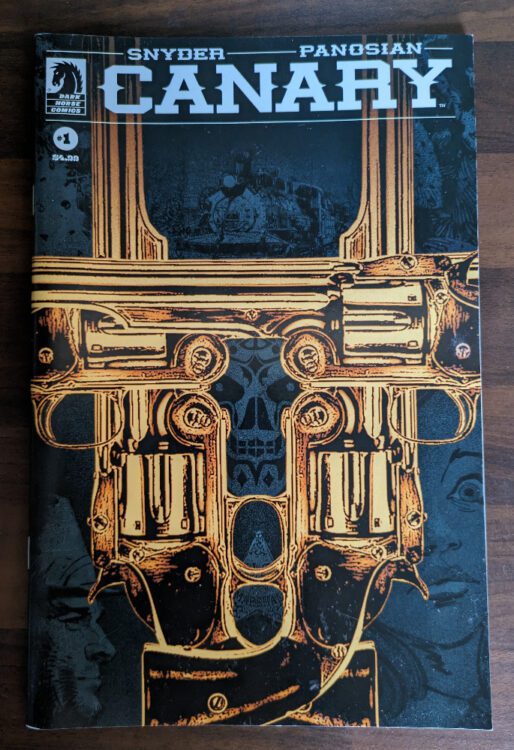
Credit: Dark Horse Comics
And a few of those other Demon Knights covers because.. why not?

Credit: DC Comics
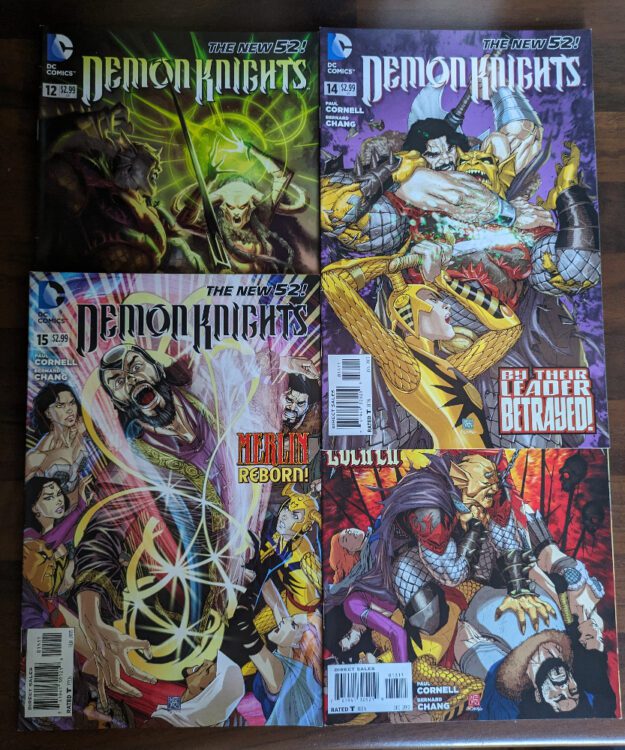
Credit: DC Comics

